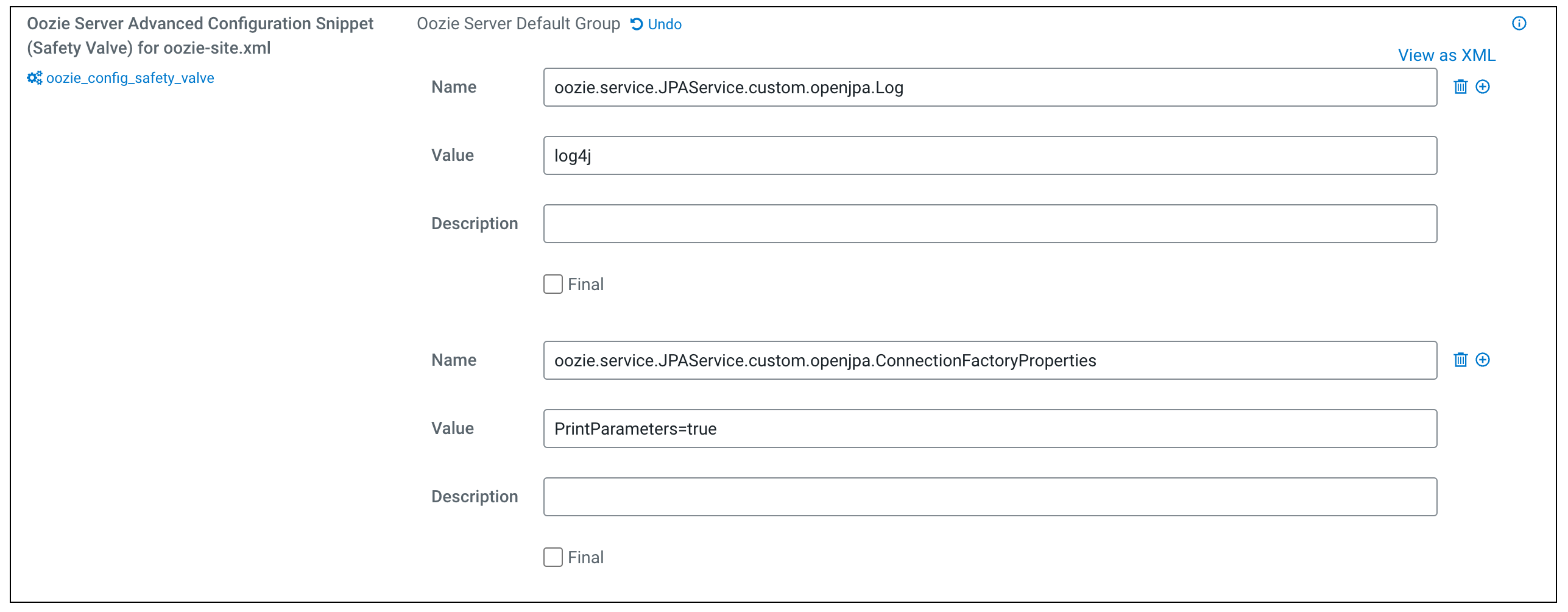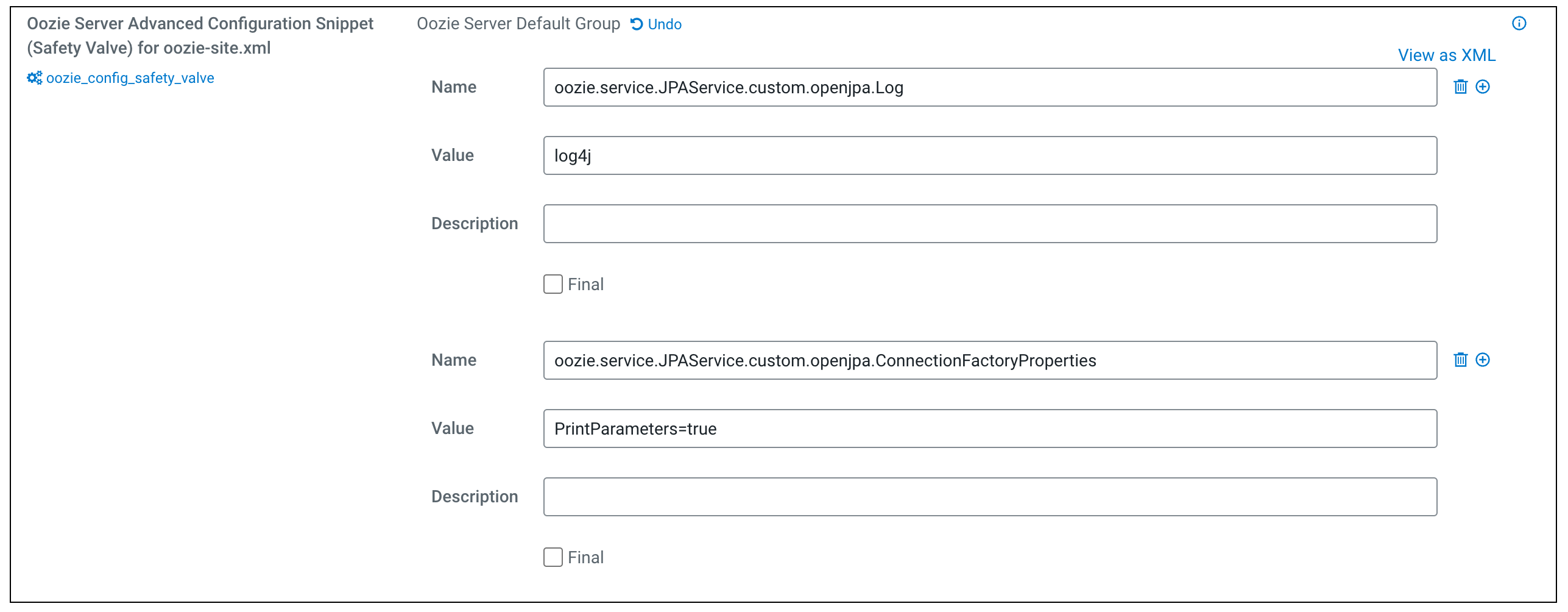OpenJPA upgrade
Explore the updates introduced in Apache Oozie following the upgrade of OpenJPA from version 2.x to 3.x. This upgrade includes new configuration properties, deprecated configuration properties, and enhanced error handling.
| Third-party library name | Upgraded from | Upgraded to |
|---|---|---|
| OpenJPA | 2.4.2 | 3.2 and later |
| commons-dbcp | 2.4.2 | 2.12.0 and later |
| commons-pool | 1.6 | 2.12.0 and later |
For more information about the exact versions that the libraries were upgraded to, see Cloudera runtime parcel's Oozie directory that is, {CDH_PARCELS_DIR}/lib/oozie/lib.
Upgrading these third-party libraries ensures that Oozie works with the latest versions of these libraries, allowing you to have a more stable and secure experience. Also, new configurations are introduced in Oozie to support this upgrade.
Changes in existing Oozie configuration
The default value of the Oozie configuration
oozie.service.JPAService.connection.data.source is updated from
org.apache.oozie.util.db.BasicDataSourceWrapper to
org.apache.commons.dbcp2.BasicDataSource. This modification was made in
response to a bug found in the earlier version of commons-dbcp, which led to the implementation
of the BasicDataSourceWrapper in Oozie. With the latest commons-dbcp update resolving the
underlying issue, the workaround has now been removed from Oozie.
New Oozie configurations
Following new Apache Oozie configurations are introduced to support the OpenJPA upgrade. The following properties can be overridden in the Oozie Server Advanced Configuration Snippet (Safety Valve) for oozie-site.xml.
- oozie.service.JPAService.pool.total.conn
- Default value: 10. The default value of this property is the same as
oozie.service.JPAService.pool.max.active.conn. - oozie.service.JPAService.pool.min.idle.conn
- Default value: 2
- oozie.service.JPAService.validate.db.query
- Default value: SELECT COUNT(*) FROM VALIDATE_CONN
- oozie.service.JPAService.custom.<***OPENJPA.CONFIGURATION***>
- Description: This property enables you to specify any OpenJPA property. For more
information about OpenJPA properties, see OpenJPA documentation. Properties set in Oozie's
persistence.xml can also be overridden using this configuration. This
property can be repeated, and to set multiple openjpa.* properties, you must define an
oozie.service.JPAService.custom.<***OPENJPA.CONFIGURATION***>configuration for each one. These properties are not available by default, but you can create them on-demand if you wish to customize additional OpenJPA configurations.Following example steps provide more information about how you can override any OpenJPA properties:
You can configure multiple openjpa.* properties in Oozie Server Advanced Configuration Snippet (Safety Valve) for oozie-site.xml as displayed in the following screenshot.
 Example on how to override the transaction isolation in Oozie Server Advanced Configuration Snippet (Safety Valve) for oozie-site.xml:
Example on how to override the transaction isolation in Oozie Server Advanced Configuration Snippet (Safety Valve) for oozie-site.xml:oozie.service.JPAService.custom.openjpa.jdbc.TransactionIsolation=serializable To enable OpenJPA debug logging through log4j, which logs into the Oozie server log files, set the following properties in Oozie Server Advanced Configuration Snippet (Safety Valve) for oozie-site.xml:
To enable OpenJPA debug logging through log4j, which logs into the Oozie server log files, set the following properties in Oozie Server Advanced Configuration Snippet (Safety Valve) for oozie-site.xml:oozie.service.JPAService.custom.openjpa.Log=log4j oozie.service.JPAService.custom.openjpa.ConnectionFactoryProperties=PrintParameters=true Add the following log4j properties in Oozie Server Advanced Configuration Snippet (Safety Valve) for oozie-site.xml:
Add the following log4j properties in Oozie Server Advanced Configuration Snippet (Safety Valve) for oozie-site.xml:log4j.category.openjpa.Tool=TRACE log4j.category.openjpa.Query=TRACE log4j.category.openjpa.jdbc.SQL=TRACE log4j.category.openjpa.Runtime=INFO log4j.category.openjpa.Remote=WARN log4j.category.openjpa.DataCache=WARN log4j.category.openjpa.MetaData=WARN log4j.category.openjpa.Enhance=WARN log4j.category.openjpa.jdbc.SQLDiag=WARN log4j.category.openjpa.jdbc.JDBC=WARN log4j.category.openjpa.jdbc.Schema=WARN
Enhanced database connectivity issue handling
When Oozie is configured to manage the database connectivity issues and if the same operation fails multiple times, then Oozie executes a validation query to check if the database connection is still open. Oozie does not force close the connection if the current retry count is less than half of the maximum retries. For example, if the maximum retries limit is set to 5, Oozie starts validating the connection on the 2nd retry attempt (floor(5/2) = 2). This validation continues until the retries either succeed or reach the maximum limit of 5.
If the connection is found to be dead or closed on the DBMS side, Oozie closes it. Then, OpenJPA automatically requests a new connection from the connection pool. This process ensures that the connection pool remains free of dead connections.
